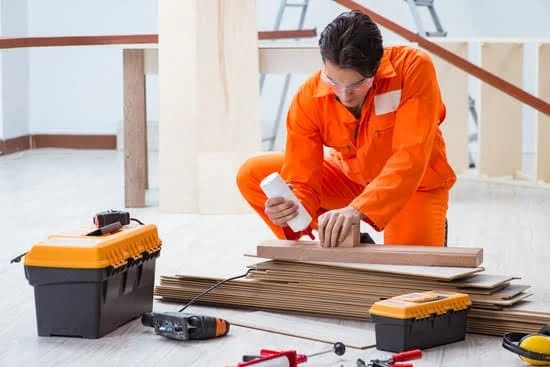A garage is a perfect place to set up a woodworking shop. It’s large enough to accommodate most of the tools and equipment you’ll need, and it’s isolated from the living areas of your house, so you can make noise and sawdust without annoying the family.
But before you can start using your garage as a woodworking shop, you need to set it up properly. Here are some tips on how to do that:
1. Set up a workbench. A good workbench is essential for any woodworking shop. It provides a place to work on your projects, and it also gives you a place to store your tools and supplies.
2. Organize your tools. It’s important to organize your tools so that you can find them quickly and easily. You may want to invest in a tool cabinet or tool rack to help you do this.
3. Install a dust collector. A dust collector is a must-have for any woodworking shop. It helps keep your shop clean and healthy, and it also helps you avoid dangerous dust inhalation.
4. Install a work light. A good work light is essential for any woodworking project. It helps you see what you’re doing, and it also helps you avoid accidents.
5. Install a heater. A heater is a good idea in a woodworking shop, especially if you live in a cold climate. It will help keep you warm and comfortable while you’re working.
6. Install a fan. A fan is also a good idea in a woodworking shop. It will help keep you cool while you’re working, and it will also help keep the dust under control.
Now that your garage is set up as a woodworking shop, it’s time to start using it! The best way to start is by browsing the internet for woodworking project ideas. There are plenty of great projects out there, and you’re sure to find one that’s perfect for your skill level and your tools.
How To Draw Plans For Woodworking Project
When starting a new woodworking project, the first step is to draw up a plan. This plan will not only help you stay organized, but it will also help ensure that your project turns out the way you want it to. There are a few things to keep in mind when drawing up your plan:
-The first step is to measure the space you have to work with and determine the size of the project you want to create.
-Next, sketch out a basic outline of the project on paper. Be sure to include the dimensions and any special features or details.
-Once you have a basic outline, begin drafting the individual pieces that will make up the project. Be sure to note the dimensions and any special cuts or angles that will be needed.
-Once you have all of the individual pieces drafted, it’s time to put it all together. Use the measurements you took earlier to assemble the project on paper, making sure everything fits together correctly.
-Finally, take a step back and review your plan. Make any necessary changes or adjustments before you get started on the project.
By following these tips, you can create a detailed, accurate plan for your next woodworking project.
What Is A Sacrificial Board For Woodworking
?
A sacrificial board is a board that is used specifically for cutting and shaping wood. It is placed on top of the wood that you are working on, and it is used to protect the wood from being damaged by the blade of the saw or the cutter. The sacrificial board is also used to help guide the wood as it is being cut or shaped.
Most sacrificial boards are made from a hard wood, such as maple or oak. They are usually about 1/4 inch thick, and they have a smooth surface that is easy to work with.
There are a few different ways that you can use a sacrificial board. One way is to place the board on top of the wood that you are working on, and then use a saw or a cutter to cut the wood. This will help to protect the surface of the wood from being damaged by the blade.
Another way to use a sacrificial board is to place it on top of the wood that you are working on, and then use a carving tool to carve the wood. This will help to protect the surface of the wood from being damaged by the carving tool.
A sacrificial board can also be used to help guide the wood as it is being cut or shaped. This can be helpful if you are not very experienced with woodworking, and it can help you to create more accurate cuts and shapes.
A sacrificial board is a great tool to have for any woodworking project. It is a very versatile tool, and it can be used in a variety of different ways. If you are new to woodworking, then a sacrificial board is a tool that you should definitely consider adding to your tool collection.
Woodworking Aprons
As a woodworker, you know the importance of wearing a good apron. Not only does it protect your clothes from sawdust and other debris, but it also keeps you safe from potential injuries.
But with so many different apron options on the market, how do you know which one is right for you? Here are a few tips to help you choose the perfect woodworking apron:
1. Consider your needs
When shopping for an apron, be sure to consider your specific needs. If you do a lot of precision work, for example, you may want an apron with a smaller pocket that can hold your tools and accessories.
2. Think about the type of fabric
Aprons come in a variety of fabrics, so be sure to choose one that’s comfortable and breathable. Cotton is a good option, but you may also want to look for an apron made from a moisture-wicking fabric to keep you cool and dry.
3. Consider the size
Aprons come in a variety of sizes, so be sure to choose one that’s comfortable and fits well. It should be big enough to cover your chest and stomach, and it should have a long enough tail to protect your back.
4. Look for extra features
Many aprons come with extra features, such as pockets, loops, and straps. Be sure to choose an apron that has the features you need, such as a tool pouch or a built-in hammer holder.
When shopping for a woodworking apron, be sure to keep these tips in mind. By choosing the right apron, you can stay safe and comfortable while you work.
Woodworking Classes For Beginners
Are you interested in woodworking, but don’t know where to start? Are you worried that you don’t have the skills or the tools to get started? Have no fear! There are plenty of woodworking classes for beginners that will teach you the basics and get you started on your woodworking journey.
One of the best ways to learn woodworking is to take a class from a skilled woodworker. There are many different classes available, from basic classes that teach you the basics of woodworking, to more advanced classes that will teach you how to make specific pieces of furniture.
Choosing the right class is important. You want to find a class that matches your skill level, and that will teach you the skills you need to know. There are many different classes available, so take the time to find the right one for you.
Once you find a class, it’s time to get started! The first step is to gather the tools and materials you need for the class. Most beginner classes require basic tools, such as a hammer, screwdriver, saw, and drill. You may also need to purchase materials for the project, such as wood, screws, and nails.
Once you have the tools and materials, it’s time to get started! The first step is to learn the basics of woodworking. This includes learning how to use the tools, how to measure and mark wood, and how to cut wood. Once you have the basics down, you can move on to more advanced projects.
The best way to learn woodworking is to take a class from a skilled woodworker. There are many different classes available, so take the time to find the right one for you. Once you find a class, it’s time to get started! The first step is to gather the tools and materials you need for the class. Most beginner classes require basic tools, such as a hammer, screwdriver, saw, and drill. You may also need to purchase materials for the project, such as wood, screws, and nails. Once you have the tools and materials, it’s time to get started! The first step is to learn the basics of woodworking. This includes learning how to use the tools, how to measure and mark wood, and how to cut wood. Once you have the basics down, you can move on to more advanced projects.

Hi everyone! I’m a woodworker and blogger, and this is my woodworking blog. In my blog, I share tips and tricks for woodworkers of all skill levels, as well as project ideas that you can try yourself.





